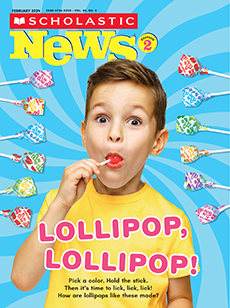Something BIG Is Coming! Lesson Plan
Academic Standards
Reading Objective:
Children will explore the phenomenon of a total solar eclipse.
Science Focus:
solar eclipse
ELA Skills:
key details, vocabulary, persuasive writing, nonfiction text features
Page 4 Skill:
read a diagram
Vocabulary:
rare, total solar eclipse, partial solar eclipse
CCSS:
RI.2.1 key details; RI.2.2 identify the main topic; RI.2.4 determine meanings of words; RI.2.5 use text features; RI.2.10 read informational texts; W.2.1 writing; SL.2.1 collaborative conversations; SL.2.3 ask and answer questions
Lexile Level:
500L
Provide students with some background on the sun.
Build background knowledge (10 min.)
Watch our video "It's an Eclipse!” After children have finished watching the video, discuss the following question:
- How can you protect your eyes during an eclipse?
Set a purpose for reading (5 min.)
- Pass out the issue and discuss the cover. What do students already know about solar eclipses?
- Next, read the As You Read prompt on the cover: “Think about why the eclipse is a big deal.” Encourage children to think about this prompt as they read.
Read together (20 min.)
Pass out the Read and Think printable. Use it to check comprehension as you read the issue together, pausing to ask the questions.
Review vocabulary (3 min.)
Next, play the online vocabulary slideshow. This issue’s featured words are rare, total solar eclipse, and partial solar eclipse.
Assessment: Reading Quiz
Pass out the Reading Quiz to review key concepts from the issue and assess students’ proficiency on key nonfiction reading skills.
- Students identify new vocabulary words by matching space-themed images in the “Space Concentration” game.
You can use our printable worksheets to focus on important ELA skills. Here’s how.
ELA Focus: Vocabulary (15 min.)
- Use the Word Work printable to deepen students’ understanding of the words rare, total solar eclipse, and partial solar eclipse.
Editor’s Pick: Persuasive Writing (15 min.)
- Students will review why the solar eclipse is a big deal and encourage others to get excited about it with the Make a Solar Eclipse Poster skill sheet.
ELA Focus: Nonfiction Text Features (15 min.)
- Students will use the The Solar Eclipse by the Numbers skill sheet to analyze important eclipse numbers.
Go to this issue’s page on the Scholastic News 2 website to get FREE online access to a Storyworks 2 fiction story about the eclipse. You’ll find it in the Resources tab.
Here is a past issue you can use to extend your lesson on the sun:
- “Sun Power!,” April 2021. Students will explore solar power and the things it can do.
You can find a higher-Lexile-level and a lower-Lexile-level version of the article online here:
- Higher-Lexile level: 570L
- Lower-Lexile level: 460L
